An inflatable de-orbit system that accelerates natural orbit decay by orders of magnitude is presented in this article. Applications of the Gossamer Orbit Lowering Device (GOLD) include de-orbit of antiquated satellites, micro-satellites, spent stages, and derelict satellites.
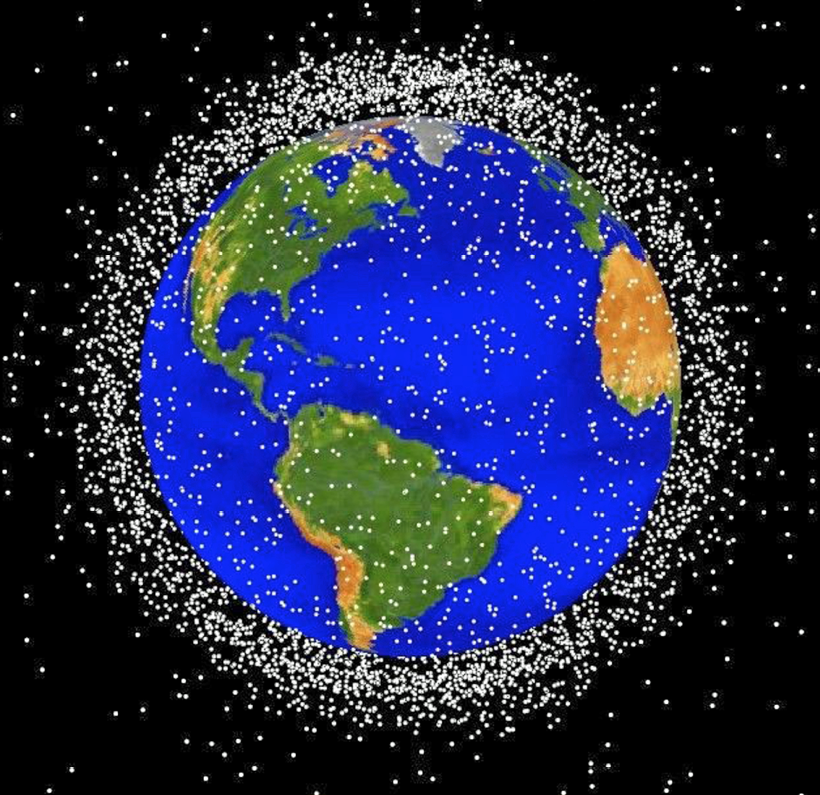
More than 500,000 pieces of debris, or “space junk,” are tracked as they orbit the Earth. They all travel at speeds up to 17,500 mph, fast enough for a relatively small piece of orbital debris to damage a satellite or a spacecraft. Illustration is courtesy of NASA.
In this patented concept, a relatively large, ultra-lightweight envelope is stowed in a small package. GOLD can be used in a number of ways and is most economical to attach it to a spacecraft or a rocket’s upper stage prior to launch.
However, GOLD could be attached to existing large orbital debris objects using, for example, an electrically propelled orbital tender. For large dense objects that could pose a hazard to people or property on the ground during reentry, GOLD can be used to target reentry into an ocean. For most LEO satellites, GOLD is more mass and cost effective than chemical propulsion and can reduce de-orbit time, in some cases from many centuries to just a few months.
Risk assessment indicates that GOLD, as compared with competing non-propulsive de-orbit concepts, does not contribute further to the orbital debris problem and has a lower risk to operating satellites.
A First Look
SPACE debris is a growing problem in many orbital regimes despite numerous and pervasive debris mitigation policies enacted and followed internationally. The 2009 collision in Low Earth Orbit (LEO) of an operational Iridium satellite and a defunct Russian satellite underscores the need for an ability to safely de-orbit large objects from popular, congested orbital regions. GOLD has the ability to de-orbit satellites in these regions in a manner that reduces the risk to other operating satellites and lowers the probability of creating new debris.
Under company internal research and development and U.S. government funding, Global Aerospace Corporation has developed a system for de-orbit of satellites and large orbital debris objects. This system concept uses a lightweight, inflated envelope to increase the drag area and accelerate the natural orbit decay process by orders of magnitude.
Potential uses of this system include de-orbit of antiquated satellites, micro-satellites, upper stages, and uncooperative satellites in orbits up to about 1200 km altitude. The de-orbit device can be attached to satellites or upper stages before launch, delivered to multiple debris objects by orbital tenders, or used for targeted and controlled reentry of large space platforms.
The GOLD system increases the cross-section area of a satellite, thereby amplifying the atmospheric drag effect, or momentum exchange, with atmospheric molecules. This momentum exchange results in a reduction of satellite orbit energy and subsequent orbit lowering without increasing the effective collision cross-section Area-Time Product (ATP) for low- and high-energy collisions that can endanger operating satellites or generate new orbital debris objects.
GOLD’s effective collision cross-section ATP is a factor of about 700-times lower than the bare satellite for high-energy (hard-body-to-hard-body) collisions because the large drag area significantly reduces decay time and because GOLD operates near Solar Maximum periods when atmospheric densities are higher.
A small government-funded feasibility study demonstrated the technical and market feasibility of a de-orbit package that can be integrated into a spacecraft for de-orbit. In this project, GAC developed a GOLD conceptual system design, evaluated performance and system scaling, assessed and compared the risk to operating satellites and of creating new debris with other de-orbit concepts, and looked at three concepts of operation. Also, the demand was assessed for such a system in light of the growing number of government guidelines, policies, and directives for orbital debris mitigation, including planned de-orbit.
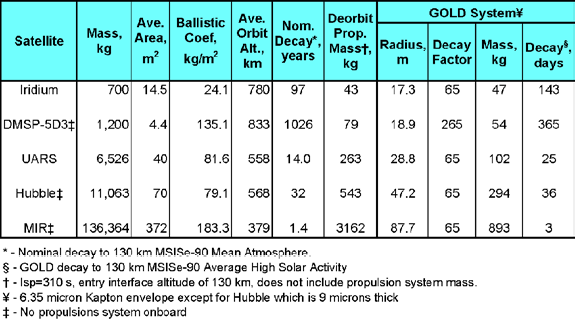
Table 1. Comparison of the performance of GOLD for a number of example space platforms
The Concept
In this patented (US 6,830,222) concept, a relatively large, lightweight envelope is stowed in a small package onboard or attached to satellites or launch vehicle stages that require eventual orbit lowering or de-orbit. One early system concept is illustrated in Figure 1 showing a fully deployed GOLD envelope attached to a large scientific platform.
Key elements of this innovative new concept are a large, ultra-lightweight and thin, inflatable envelope to reduce object ballistic coefficient by up to two orders of magnitude; controlled envelope deployment, inflation control and pressure maintenance; autonomous controller and power source; and envelope protection against UV and atomic oxygen (AO) environments.
The GOLD system requires very little mass and power, does not require an operating satellite, functions autonomously, does not further contribute to the orbit debris problem, can be designed and integrated into space vehicles planned for launch into space, can be used to de-orbit smallsats that have no propulsion systems, is capable of being installed on derelict space objects already in orbit, and is very simple.
It has been found that this device is very effective in the 750 to 900 km altitude, high inclination orbit regime, which is a highly used portion of space due largely to the sun-synchronous and communications missions deployed there. Importantly, it has a lower risk of destroying operating satellites and of creating new debris than bare spacecraft or other non-propulsive de-orbit devices such as electrodynamic tethers, gravity gradient drag tapes, or boom-supported thin film aerobrakes.
There are many satellites of significant size that could be de-orbited by a GOLD system. Here is described a preliminary performance assessment of a GOLD system for a few example space objects in a real space environment.
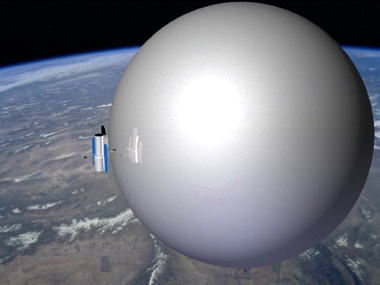
Figure 1. A GOLD system initiating de-orbit of a large observatory.
Table 1 shows a comparison of GOLD de-orbit systems and performance with a set of common assumptions and system scaling. The drag area augmentation in this comparison is a factor of 65 (except for the DMSP case, which is 265 to limit decay to 1 year), the envelope is assumed to be 6.35 micron thick Kapton and the entry altitude is held constant at 130 km.
The atmosphere for nominal decay is the Mass Spectrometer and Incoherent Scatter Experiment 1990 (MSISe-90) mean, while the GOLD decay atmosphere is assumed to be the MSISe-90 average high solar activity typical of that experienced ±1 year from solar maximum. Only Iridium has a propulsion system for carrying out delta-V maneuvers.
Note that the mass of propulsion systems is not included, which can be a large fraction of the total spacecraft mass (10-20 percent). Even so, in most cases the GOLD system requires less mass than the propellant required to de-orbit. Also note UARS and MIR are no longer in orbit but are shown only as examples for similar size satellites in similar orbits.
Example System Design
In collaboration with space inflatable softgoods manufacturer, ILC Dover, Global Aerospace Corporation (GAC) has completed a point design of the GOLD system for a large spacecraft in high orbit. In this effort, the company developed an understanding of overall system-level requirements and, with government concurrence, a reference mission and satellite for the point design work as defined.
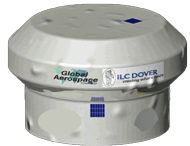
Figure 2. Stowed GOLD system
The space and aerodynamic thermal environments were analyzed and an assessment was made of their possible impact to envelope material and protection scheme options. Envelope film and coating materials were researched, including material availability, and space environmental protection schemes.
Possible envelope stowage and deployment schemes were developed, which also included sensor requirements and analysis. An overall system functional block diagram was created, point subsystem designs including preliminary mass, volume and power estimates, were developed. A system-level mass and power breakdown from which three parametric estimates of cost of the theoretical first unit were also established. Finally, computer-aided designs of the stowed system, its interface to an example satellite, and an example system deployment sequence, were developed.
A reference mission orbit is defined as 833 km altitude, 98.2 degrees inclination, sun synchronous. The reference satellite has a mass of 1200 kg and a cross-section area of about 4.4 m2. The point design GOLD system for this satellite and orbit consists of a 37 m diameter envelope, a gas inflation and pressure maintenance subsystem, along with sensors, power, and control hardware.
Figure 2 illustrates the stowed GOLD system for the example satellite and mission. For this large satellite and high orbit, the stowed system is packaged in about a 24-inch diameter by 7-inch high cylinder. What is seen here is the outer meteroid and orbit debris (MOD) shield to protect the system during the spacecraft’s operational life and GOLD dormancy phases. Also shown are very small solar arrays on the top and four sides to provide power to the battery during dormancy.
A simple pressurized gas container is adequate for inflation to a predetermined internal pressure to offset the external stagnation pressure, and is sufficient to maintain the shape essentially constant as the orbit lowering proceeds.
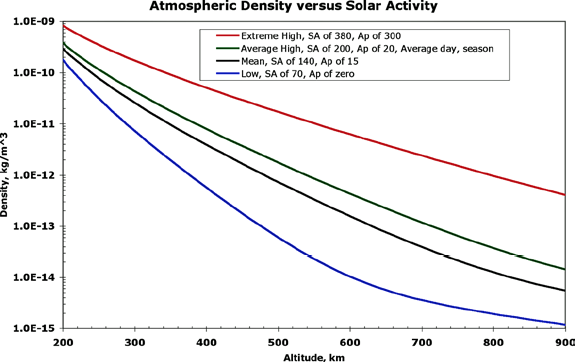
Figure 3. MSISE-90 atmospheric densities as a function of altitude and solar activity level.
Pressure maintenance involves adjusting the internal pressure of the envelope as the outside stagnation pressure increases and also to make up for gas leaks that occur as the envelope is holed by meteoroids and orbit debris.
It is anticipated that a GOLD envelope will experience a number of collisions with small particles that will generate small holes through which the inflation gas will slowly escape. Models show a surprisingly small amount of gas is needed for makeup because overall internal pressures are kept low. For the large reference system less than 200 grams of gas was required for the yearlong de-orbit. This design included meteoroid and orbit debris (MOD) shielding to protect the system during its period of dormancy before deployment. For a one year decay scenario for this large satellite, the GOLD system mass was estimated at about 3 percent of satellite mass.
The controlled deployment and inflation of the GOLD system is initiated either by command from the ground or by the use of a countdown or watchdog timer in the case of a spent upper stage or failed satellite. In the case of a cooperative satellite, the countdown timer can be periodically reset into the future. If the spacecraft fails, the system deploys automatically after the watchdog timer reaches zero and when the time is near Solar Max.
After inflation, the envelope is subject to atmospheric, solar pressure and gravity gradient forces that generate torques on the combined system. As soon as the system is deployed it will begin to be penetrated by micrometeoroids and orbital debris. Autonomous gas replenishment continues throughout the orbit lowering or de-orbit phase in order to maintain proper inflation and envelope shape to balance the internal gas pressure with the atmospheric or stagnation pressure.
Simulation, Performance, and System Scaling
During the government effort, an analysis tool was developed to simulate orbit decay under a variety of system and environmental parameters. In order to determine the impact of aerodynamic forces and heating on the envelope and determine the allowable altitude of demise of the GOLD system, near-entry conditions were analyzed.
Also determined was the impact of space environments (AO, UV, solar pressure, gravity gradient and aerodynamic forces, thermal, etc.). In order to understand gas leak and debris damage issues, extensive research was carried out into meteoroid and space debris flux models, hypervelocity impact physics, and holing models. Algorithms were developed for internal envelope pressure and analyzed the pressure requirements as a function of altitude. Deployment dynamics studies were carried out to understand and analyze deployment options.
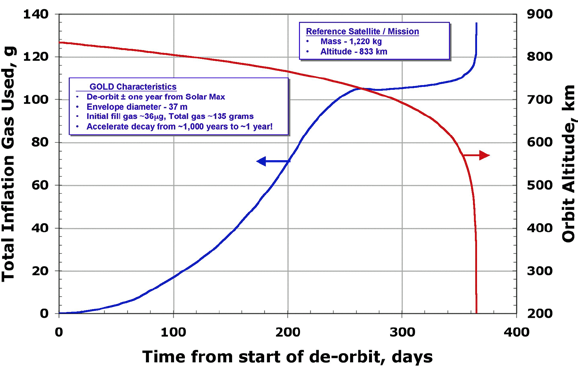
Figure 4. GOLD inflation gas usage and orbit altitude during the reference de-orbit mission.
In order to determine possible effects on internal pressure requirements, the fully deployed rigid and flexible body dynamics were analyzed. In addition, simulation models were created to predict system behavior and performance, trade studies carried out to assess performance as a function of satellite parameters such as size and altitude, assessed the implications to space operations of accelerated satellite de-orbit, and compared GOLD performance was compared to typical propulsion de-orbit.
Finally, a structural analysis of the envelope was carried out to obtain estimates of natural frequencies and deflections as a function of internal envelope pressure and estimate external forces and torques as a function of envelope design parameters. In this section, discussed will be four of the above-mentioned studies, namely, solar effects on atmospheric density, envelope holing and leakage analysis, system scaling, and GOLD performance compared with chemical propulsion.
In order to understand satellite decay times, the effects of the Solar Cycle (F10.7 number) and Geomagnetic Index (Ap) on the atmosphere density at high altitudes was researched and analyzed. Figure 5 displays Earth’s atmospheric densities as a function of altitude for various solar activity level assumptions.
Note the large density differences between models at high altitude. During high solar activity periods, it was noted that there is a 3 times reduction in decay time as compared to low solar periods. For this reason, GOLD systems will be deployed near Solar Max. Operating atmospheric drag de-orbit devices, such as GOLD, near Solar Max also significantly reduces the risk of damage to operating satellites.
Detailed envelope holing analysis was carried out with different materials and impact speeds. For this study, a nominal meteorite and orbit debris environment was used, calculated from NASA’s Orbit Debris Environment Model (ORDEM) at 833 km, an altitude at which there is a notable spike in debris flux (making this a conservative assumption due to less debris flux at lower altitudes).
Figure 4 below displays an example de-orbit profile for the reference spacecraft and orbit parameters. GOLD accelerates the natural decay process from about a 700 years to a single year. For the example 1200 kg satellite de-orbited from 833 km, only about 135 grams of gas are required to inflate the envelope and maintain the required pressure throughout the one year de-orbit even with leakage caused by MOD holing. The initial fill gas is about 36 micrograms, although a larger amount may be required (a few grams) in order to counteract initial electrostatic forces trying to keep the envelope from spreading apart.
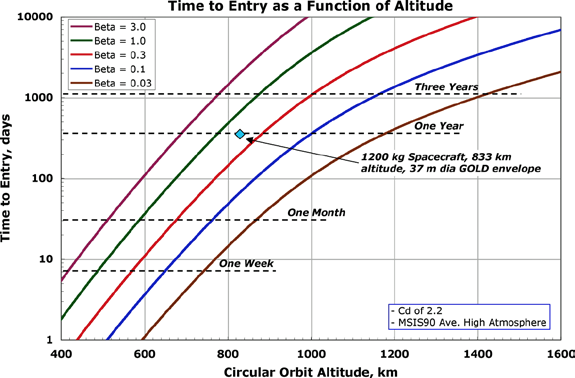
Figure 5. Time to entry of the combined GOLD/object as a function of initial circular orbit altitude for 4 different values of ballistic coefficient, ß, assuming an atmosphere typical within ±1 year of Solar Max.
Three types of system scaling have been carried out. First, the applicability of GOLD to satellites with varying ballistic coefficients in various low Earth orbits was analyzed. The mass of the envelope was then analyzed, the most massive system component, for four orbit decay periods (one week, one month, one year, and three years). This scaling is shown in Figure 5. For a typical sun synchronous 1200 kg weather satellite, depicted by the blue diamond in Figure 5, a 37 m diameter GOLD envelope lowers ballistic coefficent beta (ß) from about 125 kg/m2 to about 0.50 kg/m2.
For this satellite, orbit decay requires about 365 days. In the government-funded effort, one year was determined to be a reasonable decay time that offset the size and mass of the system. The GOLD system mass was estimated at about 3 percent of satellite mass, including much less than 1 kg of inflation gas, for this one year decay scenario.
For lighter weight objects or lower orbits, the decay time can be substantially shorter. For example, a 2 m diameter GOLD envelope, which could fit nicely in a 2 inch cube, will de-orbit a 10 kg satellite from a 650 km circular orbit in approximately 120 days. In addition, work was also completed on the system scaling for a possible upper stage demonstration. (See Figure 5.)
The GOLD system design parameters (system mass, mass fraction, and gas requirements) were explored as a function of orbital decay time and envelope materials and thicknesses and we compared the mass fractions to propulsive de-orbit scenarios. Noted was that for typical propulsion types (bipropellant and mono-propellant systems), a 1 year de-orbit GOLD system had a lower mass fraction for most envelope designs than propulsive de-orbit (considering only propellant mass).
Table 2 shows the comparison of the de-orbit system mass for a 1 year GOLD de-orbit scenario with two basic propulsive de-orbit scenarios, namely, bringing the satellite to a 25 year decay orbit or an immediate de-orbit for two different types of propulsion systems. GOLD is less massive and less costly than chemical propulsion de-orbit options, especially when propulsion is not required of a satellite mission. (See Table 2.)
GOLD can operate successfully in the 750 to 900 km altitude regime, which is a highly used portion of space due largely to the sun-synchronous and communications missions deployed there. Above 1200 km, propulsive options might require a lower mass fraction of spacecraft than GOLD, however, above this altitude range, hybrid GOLD-plus-propulsive options may result in lower overall mass fraction.
There were several key results of this simulation and modeling work. Established was the desirability for a dormancy period for any de-orbit device that uses atmospheric drag to take advantage of high solar activity levels and reduce decay times. The determination was that, at the altitude the GOLD envelope would disintegrate in the atmosphere (well below 200 km), the base satellite should already be destined to re-enter within a few days or less. At certain altitudes, noted was that solar pressure and gravity gradient forces are dominant rather than atmospheric drag. This fact has implications on the performance of non-spherical or extended-structure drag augmentation devices since there are significant periods when the orientation of the device is dictated by non-atmospheric forces and hence performance suffers.
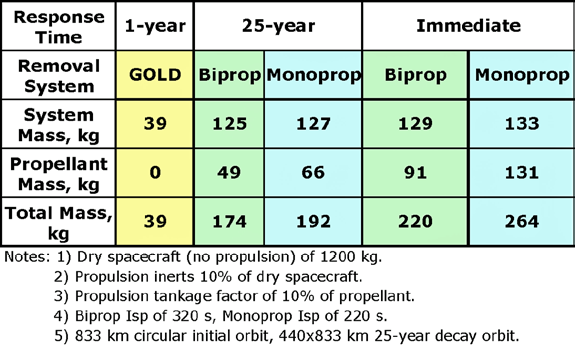
Table 2. A comparison of GOLD with chemical propulsion.
Alternate Concepts of Operation
There are many applications of this technology that involve attaching GOLD to satellites or upper stages prior to launch. Such applications include: prompt upper stage de-orbit; micro-satellite de-orbit; the augmentation of propulsive de-orbit for high altitude satellite de-orbit; and geosynchronous-transfer-orbit satellite or upper stages de-orbit or LEO circularization. In this section we will discuss two alternative concepts of operation (CONOPS), specifically, active debris removal of large LEO space objects and targeted, controlled reentry of large space platforms.
In an active debris removal CONOPS, an electric-propulsion-driven orbital tender vehicle or Orbital Transfer Vehicle (OTV) would carry ~10-15 GOLD units to be placed on derelict satellites or upper stages. An electric propulsion system is assumed for the orbital tender since the fuel mass requirements will be much smaller than for conventional propulsion systems, making removal of multiple large objects economically viable.
Preliminary analysis indicates many similarly-placed objects could be reached within about 2 years by a 500 kg (dry mass) OTV. The OTV, powered by a 12 kW solar array (BOL) and two NASA/DS1-class thrusters, requires less than 200 kg of fuel. The OTV is launched a few years before Solar Maximum, when atmospheric density is orders of magnitude greater than at Solar Minimum. The trajectory would be optimized to maximize the number of objects reached and de-orbited. The orbital tender would have the capability to rendezvous with the object, attach, activate and monitor the deployment and inflation of the GOLD system before moving on to the next derelict object.
Some large space objects require controlled, targeted de-orbit and reentry because too much material survives reentry and reaches the Earth’s surface where it can jeopardize the safety of people or property. Figure 6 depicts the CONOPS for such a scenario. In the controlled reentry CONOPS, when GOLD has reduced the orbit to the point of imminent entry, the large envelope is allowed to deflate under natural conditions to reduce drag and defer reentry a few days. Then, using careful timing, the envelope is fully inflated at the correct point in the orbit. The envelope is released a short time later when a predefined, well-characterized change in velocity has been achieved.
This sequence will cause the system to reenter the atmosphere in a controlled and targeted manner such that large, dense debris pieces fall into the ocean rather than onto land. Estimates of the maximum down-range error, based on published analysis of a similar, but not optimum, concept (Ref 1), are much less than 2,500 km. The targeted reentry implemented by GOLD will reduce the casualty estimate to acceptably low (insignificant) levels.
Risk Assessment
In this section, the risk of a GOLD-type system is assessed disabling operational satellites or creating large orbit debris and compare that risk with other candidate de-orbit concepts. Also shown are orbital debris flux projections with and without the use of a GOLD de-orbit system on all satellites under the US regulatory influence.
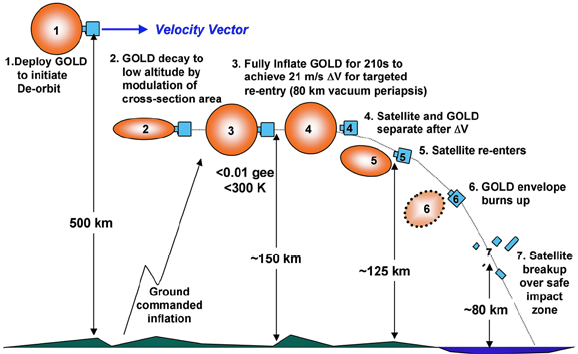
Figure 6. Targeted and controlled de-orbit concept of operation.
If a satellite-sized object weighing 1200 kg and having a 4.4 m2 cross-section area (CSA) were to collide with a very thin film, the area of the film of the cross-section area of the object would, in essence, “impact” the object. If the film were 6.35 micron thick Kapton (areal density of 9 g/m2), the total “projectile” mass would be about 0.04 kg spread out over the entire CSA. Assuming a projectile speed of 10 km/s, the energy of this projectile would then be 2x106 J. As the object has a mass of 1.2x106 g (or 1200 kg), the energy-to-mass ratio or EMR (i.e., the energy per unit mass deposited into an object) would be 1.7 J/g, well below threshold for breakup or disruption.
For a normal impact with an enclosed envelope, there will actually be two impacts with the film. For impacts with very thin films or a deployed enclosed envelope constructed of a very thin film, catastrophic fragmentation and breakup of an object will not likely occur, as depicted in Figure 7 below. However, for impacts with much thicker rigidized films or booms these are expected to cause disruption of the impactor. Despite the low EMR of the collision between a thin film and a spacecraft, appendages with low areal density, such as solar panels, will receive sufficient momentum during the collision that they will move significantly with respect to the main body and their attachment structure could be deformed permanently or even broken. This unlikely event may disable an operational spacecraft, but will not create a large number of new debris fragments.
An analysis has been carried out that estimated the effective collision cross-section Area-Time Product (ATP) for various de-orbit systems for two important impact scenarios (Ref 2). These impact scenarios are 1) low-energy collisions that can disable other satellites and 2) high-energy collisions that can generate large new debris objects.
Figure 8 compares the collision ATP for several methods of de-orbiting space hardware following end of mission. The collision ATP for de-orbit methods in the figure are shown as horizontal bars in order of decreasing threat of creating many new, large debris objects by “high-energy” collisions.
The red portion of the bars indicate the high-energy collisions contribution of ATP that is computed for collisions between debris objects with a typical dimension of 2 m (peak of debris size distribution by area (Ref 3)) and high areal density portions of the de-orbiting system, including the satellite being de-orbited.
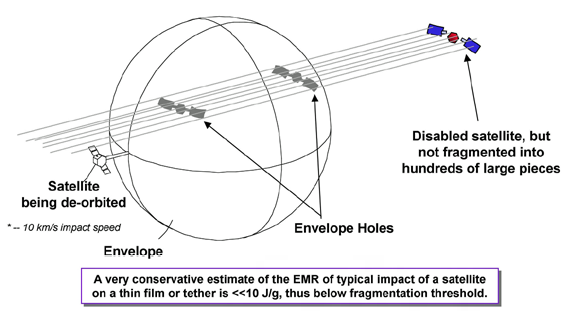
Figure 7. Satellite-to-envelope collision.
High-energy collisions are those that generate many new large debris objects (greater than 10 cm in size). Low-energy collisions are those collisions that do not generate a significant number of new large debris objects. The ATP for low-energy collisions are shown as the green portion of the bars. In all cases, the example spacecraft is a 1,000 kg spacecraft with cross-section area of 4 m2 starting at an altitude of 833 km (a typical polar sun-synchronous orbit). In addition, the orbit decay period is one year near solar max.
The bare spacecraft, with essentially no de-orbit method, takes about 700 years to de-orbit, according to NASA’s DAS, and all collisions are high-energy because all collisions are with the hard body (spacecraft). Because it may not be appropriate to compare a risk that occurs over 1 year with one that occurs over 7 centuries, the collision ATP for the bare spacecraft is calculated for only 100 years, which is a short enough time to be considered a more relevant risk for comparing against de-orbit systems. Since there are no assumed extended thin areas for the bare spacecraft, the low-energy collisions portion of the bar is zero.
Of those compared, the worst de-orbit method is a rigidizable space inflatable sphere. For the rigidizable space inflatable sphere, the areal density is assumed to be high enough that all collisions will produce many new large debris fragments. Thus all the ATP is in the high-energy collisions portion of the bar. Even this worst de-orbit method is better than the bare spacecraft over 100 years in terms of total integrated risk over the entire de-orbit period.
This difference is entirely due to the use of augmented collision CSA rather than bare drag CSA. However, this threat is all accumulated during a one-year period rather than over several centuries. This may be considered worse than leaving the spacecraft in orbit for a while.
A bare spacecraft takes several centuries to deorbit, and all its collisions are high-energy because all collisions are with the hard body (spacecraft). There are no extended thin areas. Thus the entry in the low-energy collisions column is zero. The propulsive de-orbit assumes complete immediate deorbit using propulsion. The time from the assumed delta-velocity is on the order of an hour, so the integrated area time product is negligible in terms of m2-years. This approach
obviously poses the lowest risk of collision with debris, but is expensive mass-wise and cost-wise.
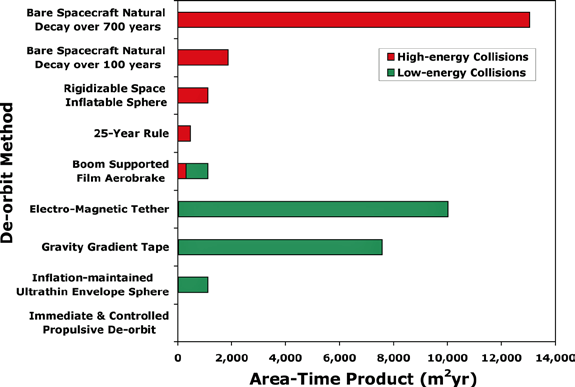
Figure 8. Area-time product summary comparison.
The inflated-maintained ultra-thin envelope (i.e., GOLD) reduced the time to deorbit from centuries to months, and the only high-energy portion of the area is the hard body spacecraft. Thus, the associated ATP is quite low.
Almost all of the area is the very thin film, which does not produce large new debris upon impact, so the ATP is the large value shown in the low energy collision column. This value is still very much lower than for the original bare spacecraft due to the different collision cross-section area augmentation.
For the rigidizable space inflatable sphere, the areal density is assumed to be high enough (100-200 g/m2) that all collisions will produce many new large debris fragments. Thus all the ATP is in the high-energy collisions column. The value is the same as for the previous row because the same area is used in both calculations.
For the boom-supported film,the assumption is the same projected drag area, but the area associated with the booms (their length multiplied by the assumed 2 m dimension of the debris) added to the bare spacecraft area (augmented by collision with 2 m debris) is used in computing the high-energy collision ATP.
The thin film between booms contributes only to low-energy collisions and makes up the bulk of the collision ATP. For both the gravity gradient tape and the electrodynamic tether, a dense tip mass of essentially zero size is assumed at the end of the tether or tape away from the spacecraft.
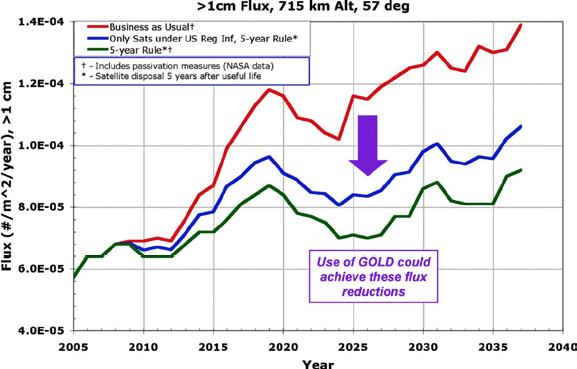
Figure 9. Orbital debris flux projection.
This tip mass is needed to allow sufficient gravity gradient torque to prevent the tether or tape from swinging backwards and upwards due to the very force they are using to deorbit the system. The collision cross-sectional area of this tip mass is equal to the area of the colliding debris object (i.e., 4m2). Thus the value in the high-energy collision column is a little larger than for the inflation-maintained ultra-thin envelope sphere.
Both the tether and the tape have very long vertical extent, so their low-energy collision cross-sectional area is augmented by multiplying their length (5 and 3.3 km long, respectively) by the 2 m characteristic length of the debris.
The greatest risk of high-energy collisions (that would create many new debris objects) occurs by leaving the satellite to decay naturally. Rigidizable Space Inflatable de-orbit systems pose the next highest risk since the envelope areal density is high enough to create large orbital debris objects or satellite disruption upon impact.
Boom-supported films are the next most dangerous. Of the remaining concepts, electrodynamic tethers and gravity gradient tapes pose the greatest risk of low-energy collisions that could disable an operational spacecraft, but would not likely create many new debris fragments. Other than propulsive de-orbit, which requires more mass, the lowest threat is attributed to Inflation-maintained Ultra-thin Envelope type systems like GOLD.
Object or satellite disruption will not occur when the impact is with very thin films (~10 g/m2) or lightweight tethers (~3 g/m) as there is too little mass in the target, hence energy, to cause disruption. However, such an impact will likely disable an operating satellite.
Boom Supported Film Aerobrakes, of which there are several different concepts, have a moderate risk of creating large debris objects due to the potential impact of large orbital debris objects or satellites with the rigid booms that are dense enough to cause object or satellite disruption.
Figure 8 displays an example orbital debris flux projections (>1 cm particles) for three forecast flux levels depending on future collisions, satellites forecasts and de-orbit assumptions for a particular orbital location, i.e., 715 knm altitude and 57° inclination. The red line corresponds to “business and usual”, with passivation, that corresponded to a projection of satellite launches from 1998 to 2006 years.
The bottom green line assumes a 5 year de-orbit rule and also roughly displays the projection of flux levels where all satellites used GOLD and were de-orbited, on average, about 5 years after their useful life. The third projection (blue line), displays what this projection would be if only those satellites under the regulatory influence of the U.S. complied with the 5-year rule or carried a GOLD de-orbit system. For this projection, a 5-year rule, implemented by use of GOLD, could reduce the particle flux by about 40 percent below “business as usual.”
Conclusions
The 2009 collision in LEO of an operational Iridium satellite and a derelict Russian satellite highlights the critical need for an ability to de-orbit large objects from popular, congested orbital regions. The altitude band from about 750-900 km is a highly used portion of space from which GOLD can successfully de-orbit satellites.
GOLD can provide safe and reliable de-orbit at a tiny fraction of the cost of a spacecraft. GOLD may be effective in de-orbiting smallsats, upper stages and objects from geosynchronous transfer orbit. Finally, the self-contained and autonomous nature of the GOLD concept is amenable to the robotic attachment of de-orbit systems to existing large debris objects to begin active debris removal from the most important orbital regions.
In summary, propulsive de-orbit offers the least risk and highest flexibility, however, propulsion requires an operating satellite to function, is the most costly if the satellite mission did not originally need it, and is the most massive. The operation of GOLD has a lower risk of disabling other operational satellites and a lower risk of creating large orbit debris objects than competing de-orbit concepts or the derelict satellite itself. In addition, GOLD does not require an operating satellite to provide attitude stabilization or power as required with propulsive de-orbit. GOLD can be integrated onto the satellite prior to launch or attached to derelict satellites by robots. De-orbit from LEO can be reduced, in some cases, from many centuries to as little as a few months.
Finally, GOLD can assist civilian, commercial and military space satellite operators in meeting their obligations to mitigate the growing space debris problem in a cost effective and low risk way.
Acknowledgments
Acknowledged is the support of Charles Sandy and his ILC Dover team in the development of the GOLD envelope materials, design, stowage and deployment concepts and the analysis of possible envelope degradation and dynamics under environmental conditions.
www.gaerospace.com/
References
1Mitchell, S. and D. Sharma, “Use of Ballutes for performing Controlled Reentry”, AAS Paper 05-063, 2005
2Nock, K. T. and Aaron, K. M., “Comparison of the Performance of De-orbit Methods in the LEO Operational Environment”, NASA/DARPA International Conference on Orbit Debris Removal, Chantyilly, VA USA, December 2009.
3Kessler, D. J., “Tools for Rule-of-Thumb Calculations for Orbital Debris”, Orbital Debris Quarterly News, Vol. 7, Issue 3, Page 3, Orbital Debris Program Office, NASA Johnson Space Center, July 2002.

Kerry T. Nock is a founder, President, and Chairman of the Board of Directors of Global Aerospace Corporation. He received his M. S. in Space Science and Engineering from UCLA. He has worked at JPL on the design of several planetary missions including Mariner 9 to Mars; Mariner 10 to Venus and Mercury; and the Voyager and Galileo missions. He managed the planetary mission studies leading to the successful Magellan Venus mapping mission and the Joint NASA/ESA Cassini mission to Saturn and Titan. He also managed the first studies of planetary aerobraking that was eventually used at Mars and Venus. He is a past Fellow of NASA Institute for Advanced Concepts (NIAC) and PI for two NIAC Phase II studies, one developing a concept for networks of guided balloons for Earth science and the other study to develop an Earth-to-Mars transportation architecture.
He is principal inventor of two new devices including a safe and low cost satellite de-orbit system for low-Earth orbit spacecraft and a revolutionary and scalable entry system that can offer more returned mass for same launch mass while enabling the use of small diameter launchers. He was the principal investigator of a unique subsea and aerospace system development for the Department of Defense. Mr. Nock has authored or co-authored over 80 papers and articles and is a past associate editor of the American Institute of Aeronautics and Astronautics (AIAA) Journal of Spacecraft and Rockets. Mr. Nock is an expert in systems engineering, celestial mechanics, mission design and analysis, advanced studies and technology development and flight operations planning. He has carried out a variety of activities in aerospace systems development.

Dr. Kim Aaron is Global Aerospace Corporation’s Chief Engineer. Dr. Aaron earned PhD and MS degrees from Caltech in Aeronautics, B.S. in the Honors Mechanical Engineering program at McGill University, Montreal, Canada, and a Diploma d’Etudes Collegiales, in Pure and Applied Science from Vanier College, Montreal, Canada. Dr. Aaron has a very diverse background covering wind tunnel testing, water channel testing, bicycle fairings, systems engineering, comet landers, microrovers, balloon systems, rain simulation, vibration isolation for microgravity experiments, aeroelastic phenomena, flow visualization, fluid dynamics.
He is a co-inventor of a satellite de-orbit system for LEO spacecraft and a new type of atmospheric entry system. He has extensive design experience in aerospace systems design, particularly mechanical design. Dr. Aaron taught “Aircraft Performance and Dynamics” at Caltech for four years and “Introduction to Space Technology” at UCLA for three years. These cross-fertilizing experiences feed Dr. Aaron’s innate creativity and provide a strong systems-oriented approach to problem solving and invention. Dr. Aaron has more than 40 published papers covering many topics.


